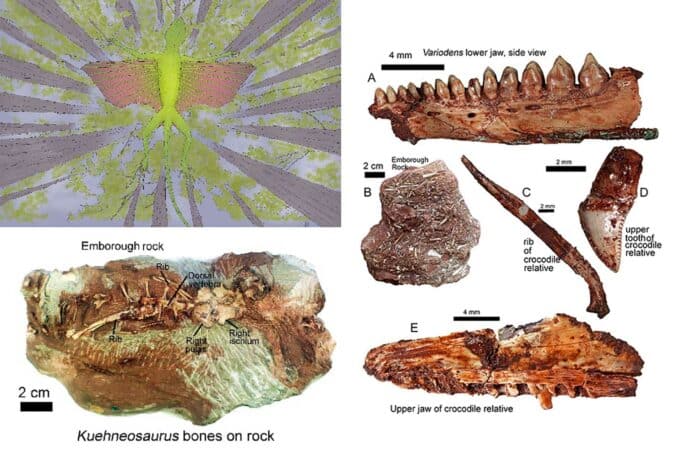During the Late Triassic and Early Jurassic periods, the region around Bristol and South Wales was an archipelago of islands inhabited by various small-sized tetrapods (four-limbed vertebrates). The largest of these paleo-islands was Mendip Island, which currently comprises the Mendip Hills. This area has been the location of some well-known fossil sites. However, these sites have been thoroughly described once a new study presents new data on three fossiliferous sites.
Researchers at the University of Bristol have revealed gliding winged reptiles were amongst the ancient crocodile residents of the Mendip Hills in Somerset. Kuehneosaurs resembled lizards but were more closely related to the ancestors of crocodilians and dinosaurs. These small animals were of a size that could easily fit in the palm of a hand, and there were two known species. One had extensive wings, while the other had shorter wings made from a layer of skin stretched over their elongated side ribs, enabling them to swoop from tree to tree.
Like the modern flying lizard Draco found in southeast Asia, Kuehneosaurs likely moved on the ground and climbed trees in search of insect prey. When startled or upon spotting a flying insect, they could launch themselves into the air and land safely up to 10 meters away.
Mike Cawthorne, a University of Bristol Masters student, discovered Kuehneosaurs. Cawthorne was researching reptile fossils from limestone quarries on the Mendip Palaeo-island, the largest sub-tropical island during the Late Triassic and Early Jurassic periods.
In addition to discovering Kuehneosaurs, the study also documents the presence of reptiles with complex teeth, including the trilophosaur Variodens and the aquatic Pachystropheus. Pachystropheus is suggested to have had a lifestyle similar to a modern-day otter, likely feeding on shrimps and small fish.
The preservation of these ancient reptile fossils suggests that the animals either fell or their bones were washed into caves and cracks in the limestone.
University of Bristol Masters student Mike Cawthorne said, “All the beasts were small. I had hoped to find some dinosaur bones or even their isolated teeth, but I found everything else but dinosaurs.”
“The collections I studied had been made in the 1940s and 1950s when the quarries were still active, and paleontologists could visit and see fresh rock faces and speak to the quarrymen.”
Professor Mike Benton, from Bristol’s School of Earth Sciences, explained: “It took a lot of work identifying the fossil bones, most of which were separate and not in a skeleton.
“However, we have a lot of comparative material. Mike Cawthorne compared the isolated jaws and other bones with more complete specimens from the different sites around Bristol.”
“He has shown that the Mendip Palaeo island, which extended from Frome in the east to Weston-super-Mare in the west, nearly 30 km long, was home to diverse small reptiles feeding on the plants and insects.”
“He didn’t find any dinosaur bones, but, likely, they were there because we have found dinosaur bones in other locations of the same geological age around Bristol.”
Bristol’s Dr David Whiteside added: “The bones were collected by some great fossil finders in the 1940s and 1950s, including Tom Fry, an amateur collector working for Bristol University who generally cycled to the quarries and returned laden with heavy bags of rocks.
“The other collectors were the gifted researchers Walter Kühne, a German imprisoned in Great Britain in the 2nd world war, and Pamela L. Robinson from University College London. They gave their specimens to the Natural History Museum in London and the Geological collections of the University of Bristol.”
Journal Reference:
- Michael Cawthorne, David I. Whiteside, Michael J. Benton et al. Latest Triassic terrestrial microvertebrate assemblages from caves on the Mendip palaeoisland, S.W. England, at Emborough, Batscombe and Highcroft Quarries. Proceedings of the Geologists’ Association. DOI: 10.1016/j.pgeola.2023.12.003
